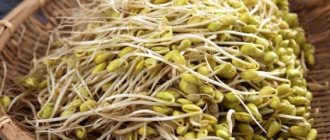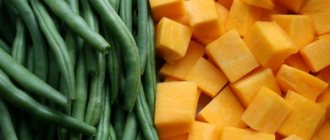It is not surprising that the word “rutabaga” tells us little: after all, it is not on store shelves. Despite everything, people show interest in this vegetable (especially those who seek to diversify their diet). On online culinary resources there are many recipes for rutabaga dishes: soups, main courses, appetizers, side dishes, porridges - you name it! Residents of Northern Europe consume this vegetable along with beets, potatoes and carrots. Rutabagas are given tribute in Estonian, German, Irish, Finnish, French, and Canadian cuisine. It is especially appreciated in Germany: they prepare very tasty rutabaga delicacies. In this country there is even a popular fairy tale about rutabaga, similar to the Russian “Turnip”.
Maybe it’s time for us to “reanimate” an ancient vegetable from oblivion? First, let's take a sightseeing tour of the “rutabaga kingdom.”
Swede. Photo: Diana Sokolova
Story
Rutabagas are a close relative of turnips and cabbage (their interspecific hybrid). It appeared in Europe and the Mediterranean at the very beginning of our era. Interestingly, rutabaga has not yet been found anywhere in the wild. The crop was widely cultivated first in European countries, and in the second half of the 19th century it came to Canada, the USA, Japan, New Zealand and Australia, where it immediately became popular. Rutabagas were brought to India and China from England in the 20th century.
The time when rutabaga acquired Russian “citizenship” has not been precisely established. There is information that it was brought to us from Greece in the 14th century. One way or another, by 1800, rutabaga took the place of the main vegetable crop in the Saratov, Simbirsk, Voronezh, Kursk, Little Russian, and Slobodo-Ukrainian provinces. Later, together with farmers from different regions, she developed Siberia. However, after the advent of potatoes, its cultivation decreased sharply. For what reason she “gave up without a fight” is difficult to say now.
What composition may be responsible for the benefits of rutabaga?
The calorie content of a root vegetable per 100 g is 39 kcal for a cooked vegetable and 36 kcal for a raw one. This amount of product contains:
- 7% of the daily fiber requirement for the cooked version and 10% for the raw version;
- 31% of the daily dose of vitamin C for cooked vegetables and 42% for raw ones;
- 9-10% potassium and manganese;
- 5-6% each of magnesium, phosphorus, calcium, folate, vitamins B1, B6.
The root vegetable also contains carotenoid antioxidants. But their number is not precisely estimated.
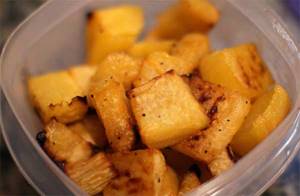
Description of the plant
Rutabaga is a biennial plant. In the first year, the roots and rosettes of leaves are formed and strengthened, and in the second year you can expect flowering and fruiting. The appearance of root vegetables depends on the variety - they can have a round, oval, flattened shape, purple or gray-green color. The pulp is white, yellow, orange. The fruits are pods with many seeds.
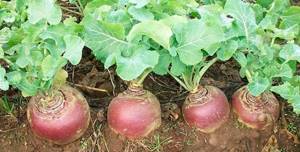
It’s incredible, but true - ordinary rutabaga contains such an incredible amount of useful substances that in some respects it surpasses the recognized “leaders”: for example, it contains more vitamin C than cranberries, and this vitamin in the vegetable is more resistant to destruction during storage and cooking. And there is more potassium needed for the heart than in grapes. In addition, the vegetable contains: organic acids, starch, mono- and disaccharides, dietary fiber, ash, vitamins A, B1, B2, B3, B6, B9, H, PP, magnesium, phosphorus, iron, calcium, sodium.
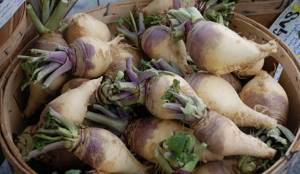
Beneficial properties of rutabaga for digestion
The vegetable is rich in fiber: one average specimen gives a person 17-20% of the daily requirement of plant fiber.
On this basis, they conclude that it is useful for maintaining healthy microflora and normalizing intestinal function, in particular for eliminating chronic constipation.
This is most likely true. But no clinical studies have been conducted that would confirm the positive effect of rutabaga on the health of the human gastrointestinal tract. Additionally, the vegetable's fiber is mostly of the insoluble variety, which is not as beneficial as the soluble variety, such as pectin or inulin.
Preparation and storage of rutabaga
- Rutabagas must be collected before frost; frozen specimens will not be stored for long.
- For harvesting, you need to choose a dry, warm day.
- Vegetables are pulled out by hand, shaken off the ground, and hung to dry in a shaded place.
- Only undamaged tubers are suitable for long-term storage.
- The tops should be trimmed, leaving 2-3 cm of petioles.
- Root crops are stored in boxes, sprinkled with sand or dusted with chalk.
- The optimal temperature is 4ºС.
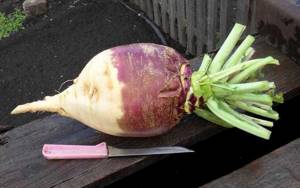
Regular consumption of vegetables is certainly beneficial, but it should be clearly understood that different crops are not suitable for everyone; almost every plant has contraindications for a number of diseases. Therefore, it is worth carefully studying their properties.
We invite you to familiarize yourself with the list of medicinal qualities of broccoli, the possibilities of using “sweet potatoes” - sweet potatoes - for medicinal purposes, and advice from traditional healers on the use of eggplants.
Do you, dear readers, use rutabaga in your diet? Have you ever used folk recipes from this root vegetable? What are the results?
Could rutabaga be good for cancer?
Some time ago, publications began to appear on the Internet claiming that the root vegetable was a cure for cancer. Such assurances have no evidence.
Test tube studies were conducted using phenolic extracts of sprouts, seeds and roots. And not root vegetables prepared for consumption. In these studies, the extracts were shown to be cytotoxic to certain cancer cell lines. But such results do not in any way confirm that stewed rutabaga helps defeat oncology.
Another justification for the presence of anti-cancer activity in the root vegetable is due to the presence of antioxidants in it. These are mainly vitamin C and carotenoids. These compounds are actually present in the product and destroy free radicals that contribute to the appearance of cancer.
However, the overall antioxidant activity of the vegetable is not high.
Swede. Long way to our table
I was forced to write about rutabaga by chance.
While looking through ads on Avito on the Internet, I came across this: “I’ll buy any table rutabaga. I beg you, SELL!!!" On our seven-dacha website there is an article by Vera from Orel, I really hope that she will not be offended by me if I add a little to her material. Rutabaga spread to Europe as a completely edible and tasty vegetable during the Middle Ages. She was especially loved in Germany. One of the sweet varieties of rutabaga was Goethe's favorite vegetable. If we are unlikely to find a person who does not know the fairy tale about the turnip, then among the Germans the fairy tale about rutabaga and the mountain spirit Rübezale, incorrectly translated into Russian with the word “Reposchet” instead of “Brukvoschet,” is also popular. This translation error can easily be explained, the point is the similar sound of the words “turnip” and “rutabaga”, because the Germans still call rutabaga a white turnip. Rutabaga came to England in the 16th century, but very soon, along with turnips, it became a common food product, and rutabaga with meat became a national dish.
But in Rus' it was little known and we hardly used it until the 20th century. My mother-in-law told me that rutabaga was grown in the fields in the Leningrad region before the war, and these were table varieties, not fodder. Now you can buy rutabaga from private traders as quickly as possible; the collapse of agriculture has hit it too. It's a pity. This root crop has a rare unpretentiousness, can withstand autumn and spring frosts down to -8 degrees, and can produce good yields on clay soils, peat bogs, and drained swamps. Prepare the soil for it in the same way as for potatoes.
I grew the varieties 'Children's Love', 'Bright Dream', 'Vilma', 'Krasnoselskaya'. They all taste similar to each other, the difference is in size, and in the shape of vegetables.
Vera wrote about agricultural cultivation techniques, I’m doing a little wrong, but that’s not what I’m talking about now. I selected these root crops for forcing greens in the spring. They will need to be planted tightly in boxes with soil, which are installed in a semi-dark room, then the plants will grow partially bleached shoots, very tender and juicy, having great nutritional value. They, like rutabaga itself, do not have a turnip smell or taste. Like Vera, I don’t really like turnips, unless it’s in soup, although I grow them. By the way, I really love the salad turnip 'Kanamachi' (its leaves contain as much vitamin C as sweet peppers).
Seeds of various varieties of table rutabaga have now appeared in stores. All of them came from varieties of Swedish selection. All of them have yellow flesh; if you follow the watering rules, it will always be tender, juicy, and sweet.
For lovers of vegetable dishes, rutabaga provides enormous possibilities for imagination. It goes well with any vegetable, as well as mushrooms. Adding herbs and various spices allows you to get a completely new dish. The combination with meat, poultry, fish turns the dish into a dietary one, unlike the combination with potatoes. Rutabaga is indispensable in the treatment of diabetes and obesity due to its low calorie content. Pudding made from rutabaga, dried apricots, cottage cheese and semolina will appeal to children. The rutabaga pulp is sweet and juicy, you can simply grate it, add carrots, apples, or you can add onions, dill, and garlic. It's a matter of your taste. If there are inflammatory processes in the stomach and intestines, then it should be consumed baked, stewed, or boiled. A delicious dish is made from fried rutabaga.
Fried rutabaga with onions and carrots cooks for 45 minutes. Feel free to add greens and various seasonings to which you are accustomed.
If you keep the dish in a saucepan longer, the rutabaga takes on a different taste. It will taste straight from the oven! The color will be darker.
If you are cooking with meat, you can add everything at once; only those spices and herbs that do not tolerate prolonged heating can be left until the end of cooking.
I was struck by the limited number of comments following Vera's post. I understand that even in prehistoric times, tastes in food were divided. Remember, in the Odyssey, the Greeks who ate bread were contrasted with the barbarians who ate lotus. At no stage of its development has humanity fully utilized the food resources at its disposal. Here I am addressing smart and inquisitive minds, there are many of them on the site. People are afraid to accept new food, afraid to give up their prejudices. Most people “like what they eat” rather than “eat what they like.” We do not want to free ourselves from traditional antipathy to “foreign” food, because our habits, emerging in early childhood, become instinctive. And here we are responsible to our children, grandchildren, great-grandchildren. If not us, then WHO?
Do rutabaga have immune benefits?
The product is known to improve immunity. Theoretically, several explanations can be found for this point of view:
- The root vegetable contains a lot of vitamin C, which is necessary for the functioning of the immune system;
- antioxidants (mostly vitamin C) destroy free radicals and fight chronic inflammation;
- fiber supports the functioning of the intestinal biocenosis, which plays an important role in the immune response.
It is logical to assume that rutabaga is a healthy vegetable for the immune system. This may be true, but there is no scientific evidence.
At the same time, there are not many carotenoid antioxidants in the root vegetable. There is less vitamin C than in other plant foods known for their high concentrations of this compound. And fiber is mainly in the insoluble form. To support the work of symbiotic bacteria, a soluble version is needed.
What are the benefits of rutabaga potassium?
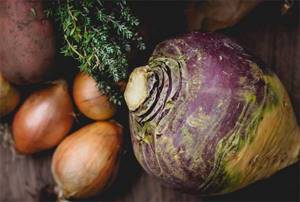
Getting enough potassium into your body and maintaining the proper potassium:sodium ratio are essential to staying healthy. After all, it is the disturbed balance between the amount of potassium and sodium that is one of the reasons for the development of hypertension.
The diet of modern man is such that there is not enough potassium in it. Therefore, all products rich in these microelements are regarded as healthy. And rutabaga is no exception.
However, the amount of potassium in it is less than in baked potatoes. Not to mention such leaders in the concentration of this microelement as walnuts, spirulina, dried apricots or beet tops.
Rutabaga for weight loss: benefit or harm?
This is a weight loss friendly product. With a low calorie content (36-39 kcal per 100 g), it saturates well, as it contains a significant amount of fiber that fills the stomach.
This is the main beneficial property of the root vegetable for weight loss. But others can also be specified.
- So if rutabaga actually has a positive effect on the intestinal biocenosis, this may help you lose excess weight. After all, restoring the functioning of the microflora is important for losing weight, since the composition of the intestinal microbiota in overweight people is always changed.
- Anti-inflammatory activity helps fight low-grade inflammation in the body that occurs with significant excess body weight. The vegetable does not have pronounced anti-inflammatory properties. But at least it doesn’t contribute to inflammation, like sugar or fast food does.
- The presence of fiber is useful for slowing down the digestion of food, and, therefore, for preventing sudden rises in blood glucose after eating, which lead to abdominal obesity.
What are the recipes for making rutabaga?
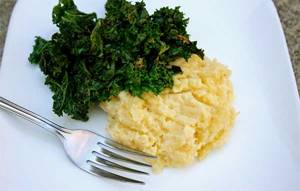
The vegetable is eaten raw and subjected to heat treatment: boiled, fried, stewed, baked.
Placed raw in salads. Goes well with carrots and apples.
You can make puree from rutabaga:
- Swedish version of root mousse with potatoes and carrots (recipe);
- or puree from only one root vegetable (preparation method).
Soups are cooked with vegetables:
- soup with turmeric and barley;
- soup with cheese and pine nuts.
You can use rutabaga:
- stew in sour cream;
- or just fry on a baking sheet.
You can preserve the root vegetable for the winter by first frying it.
Winter rutabaga preparations: recipes
So that you can enjoy this vegetable on cold days, it is canned. Here are three delicious recipes.
Plain Canned Rutabaga
The simplest and fastest option.
Ingredients:
- 1-2 rutabaga;
- 1 liter of water;
- 1 tbsp. l. vegetable oil;
- 0.5 tsp. citric acid;
- 1 tbsp. l. salt.
Preparation:
- Peel the root vegetable and cut into cubes.
- Place in a saucepan with oil. Blanch for 4 minutes.
- Prepare the brine in a separate pan. To do this, dissolve salt in water and boil for 3-5 minutes. At the end add citric acid.
- Place the vegetable in the prepared jar. Pour in brine.
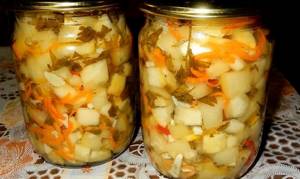
Pickled rutabaga with vinegar and nutmeg
The recipe will delight you on cold autumn or winter days and will replenish the body’s vitamin reserves. Cloves and nutmeg make the dish very spicy.
Ingredients:
- 1 large rutabaga;
- 1 liter of water;
- 200 g honey;
- 100 ml apple cider vinegar;
- 3 buds of cloves;
- 1 tsp. ground nutmeg;
- 50 g salt.
Preparation:
- Peel the rutabaga and cut into slices.
- Place in a container prepared for storage.
- Mix all other ingredients in a saucepan. Cook until the honey is completely dissolved.
- Cool the solution.
- Pour it over the root vegetable.
Stewed rutabaga in oil for the winter
You can cook more and serve some of the stew for dinner. Due to the large amount of oil, the shelf life increases. If you do not plan to remove the workpiece for a long time, then you can pour it less.
Ingredients:
- 2 rutabaga;
- 3 carrots;
- 1 onion;
- 1 small zucchini;
- 1 tbsp. l. 9% vinegar;
- 0.5 tbsp. vegetable oil;
- dill greens;
- salt, sugar to taste.
Preparation:
- Wash, peel and cut all vegetables into cubes.
- Fry carrots and rutabaga in a frying pan.
- Then add zucchini, onions, herbs and sugar. Add salt.
- Mix everything and simmer over low heat for 40 minutes.
- 5 minutes before the end, pour in the vinegar.
- Divide the stew into jars and roll up.


